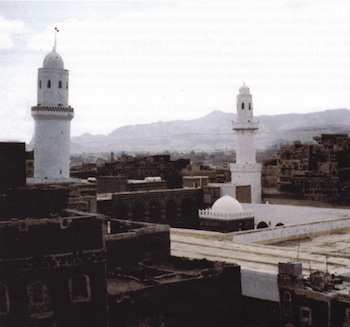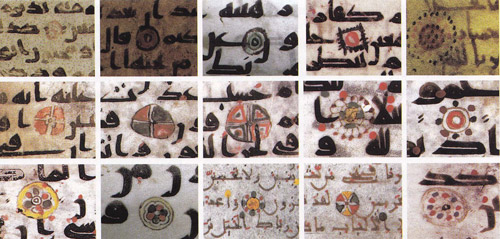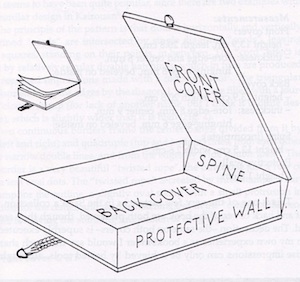Qur'an and Scrolls - Early Qur´an Fragments from the Great Mosque in Sana’a
Origin and time: Sana’a, 1st century of Hijrah/7th century AD
Extracts from a publication by: Deutsches Archäologisches Institut, Orient-Abteilung, Außenstelle Sana´a, 2003
The Great Mosque in Sana’a/Yemen is one of the oldest mosques in the world. It is said that the mosque was built at the command of Prophet Muhammad (peace be upon him) himself. During construction works in 1972 – when the western façade had to be rebuilt after the wall had caved in due to heavy rainfalls the year before – a space between the ceiling and the roof of the mosque was discovered. About 15,000 manuscript fragments from 950 different copies of the Qur’an were found. This discovery was not only spectacular because of the sheer number of fragments, but also because most of the great old Arab libraries were destroyed during the course of history and early Islamic manuscripts are very rare. Qadi Ismail al-Akwa, then Head of the Department of Antiquities in Sana’a, recognised the importance of the discovery at once and arranged for foreign sponsors and experts to be involved in the restoration and conservation of the precious fragments. In 1980, a German Project for the Restoration and Cataloguing of Early Islamic Manuscripts in Yemen, financed by the Foreign Ministry of the then Federal Republic of Germany, was initiated. Ursula Dreibholz, an expert in book restoring, was entrusted with this task, and, thanks to her commitment, the fragments are exhibited in the Manuscript Library in Sana’a today and are accessible to scholars from all over the world.
Although no written dates were found on the fragments themselves, it is possible to date them through stylistic criteria. Some of the fragments from Sana’a can be dated back to the 1st century of the Hijrah (7th century AD). Their size varies from 4x5 cm to 45x50 cm.
The Holy Qur’an
Originally the Qur’an had not been documented as such, but parts were written on parchments, bones and palm leaves kept in different places. Uthman, the third rightly guided caliph, eventually ordered a comprehensive manuscript to be compiled.
Although the Arabic script was modified in the course of time to facilitate reading, the Arabic language did not change, nor did the content of the Holy Qur’an. There are no variants of the text of the Holy Qur’an and no variations of the text were found among the numerous Qur’anic fragments in Sana’a.
The Holy Qur’an was written in what is referred to as rhymed prose, consisting of 114 chapters (surahs) divided into verses (ayats) of different lengths. Other divisions of the text were sometimes made for different purposes whereas the segmentation was essential for decorative elements to be inserted. The actual copying of the Holy Text was given top priority though and was considered a holy deed.
Script
Like in other Semitic languages, the Arabic script is based on consonants, with just three vowels (a, i, u), only the long ones being written. Due to basic forms, which can be used for several letters, even the consonants can be difficult to read. In former times, when most Muslims new the Qu’ran by heart, this was no problem. However, after the rapid expansion of the Islamic faith, many newly converted Muslims had difficulties reading the “defective” form of the script. In order to avoid misinterpretations of the holy text and to help distinguish letters with the same basic form, diacritical marks were introduced.
b = ب
th = ث
j = ج
h = ح
kh = خ
s = س
sh = ش
Vocalisation points followed only slightly later. These elements were often added to older texts, but it is almost impossible to retrace such details nowadays.
Hijazi is the oldest form of the Arabic script and very rare, which renders the spectacular examples of the script found in the Great Mosque of Sana’a all the more impressive. Most of the manuscripts found are written in Kufic script.
Ornamentation
The decoration of Qu’ranic manuscripts resulted from a very practical reason: the segmentation of the text. Verse stops are quite simple and yet may become multi-faceted elements of decoration. The fifth and tenth verse stops are usually colourfully decorated. Still, the most beautiful decorations of Qur’anic manuscripts can be found in the spaces between the surahs. The repetition of simple geometrical patterns or plant-derived forms, drawn in ink or – even more often – in vivid colours of green, yellow, orange or red between the surahs can create quite stunning effects.
Bookbinding
Among the Qur’an fragments found in Sana´a, 95 fragments of book covers were discovered – covers with a paper core, containing paper leaves, but also older covers with wooden boards, containing parchment textblocks. The formats of the Qur’an were mostly oblong in early times. The bookblock (the sewn leaves of a book without the cover) was well protected by a box enclosing it. The front and back covers were wooden and very sturdy. In addition, a leather wall protected the bookblock on the three open sides. The fourth side, the back or spine, the edge of the bookblock where the gatherings are sewn together equaled the part of the binding covering it, which is why the spine had to be of the same height as the textblock. The fixture to keep the box closed consisted of one or several pegs inserted into the edges of the front cover and leather loops or thongs inserted into the edges of the back cover, which were then slipped over the corresponding pegs.
Source: Ursula Dreibholz: “Some aspects of early Islamic bookbindings from the Great Mosque of Sana´a, Yemen”
in « Scribes et manuscrits du Moyen-Orient »,
Bibliothèque nationale de France, 1997






